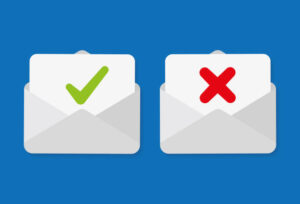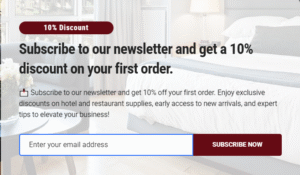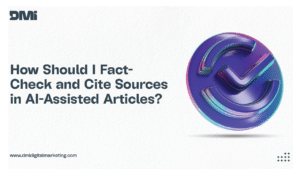Jump to Section
ToggleWhy do some email marketers often struggle to achieve their goals? Based on email deliverability tests alone, the average rate is 85.7%, which means around 14.3% of emails never reach their intended destination (Emailtooltester, 2023). Email marketing is a multibillion-dollar industry, but success isn’t cheap; it depends on several critical factors. This article explores some of them, sharing the common pitfalls that can hinder email campaigns and offering practical tips for overcoming these challenges.
5 Common Email Marketing Mistakes To Avoid

1. Ignoring Lead Magnets or Offering Less Valuable Ones
Ignoring lead magnets or offering weak ones can cause email campaigns to fail. Lead magnets are essential tools for growing and nurturing your email list by providing value in exchange for their email. We see some businesses offer just an email subscription as a lead magnet. That’s not compelling unless you offer exclusive content or a specialized resource.
Successful lead magnets typically provide something more valuable, such as an in-depth industry report, a downloadable toolkit, or an exclusive discount or webinar that targets specific pain points and provides immediate, actionable value. See the following sample we created for one of our clients:

This type of lead magnet grabs attention and can drive purchase decisions– or whatever goal you’ve set for your newsletter.
2. Not Doing Segmentation
One of the key mistakes people make in email marketing is not segmenting their lists of consumers. Segmenting will help you curate and send messages to your consumers based on their individual needs and experiences. Imagine sending out welcome mail to long-time subscribers of your newsletter. This will look weird to them. MailChimp, one of the top email marketing platforms, highlights his reality in one of its blogs:
“Unfortunately, some businesses still send the same email with the same content to everyone on their list, providing a less personal experience for all their email subscribers. Most of those emails go unread with no action taken because they’re too general to speak to any single group of audience members.”
From this insight, we know that email marketing is not a “one-size-fits-all” and should be tailored to the recipient based on their past behavior, interests, and stage in their buying journey. (More on this in the next section)
3. Limiting Newsletters to Sales
Sending newsletters only when there are promo sales or discounts is a very wrong approach to email marketing. Treat your email campaigns like the old saying, “A friend in need is a friend indeed.” Don’t show up for your customers only when it’s sales time. Be their friend in need.
Reach out often, maybe weekly or bi-weekly. Show them you genuinely care through, let’s say, birthday and holiday wishes, educational content that fits their business or personal needs, and brand updates that matter to them–think new products, relocation, or a new payment system. They shouldn’t feel like you’re spamming them with a promo sales newsletter.
4. Not testing CTA
A common misstep in email marketing is assuming one call-to-action (CTA) fits all. While generic CTAs (such as ‘Read More’ or ‘Buy Now’) aren’t inherently bad, relying on them without testing can hurt performance.
Marketers believe that the key to successful CTA is to run A/B tests and determine what resonates best with your audience or what converts them. Sometimes, you can discover that specific CTAs perform better, such as ‘Link My Account’ or ‘Add me to the Waiting List’. The lesson: don’t guess, test as much as you can. Some businesses even experiment with dual CTAs in a single email targeting different types of readers or offering two value-driven paths.
5. Focusing on Product Showcase Only
This is for e-commerce brands. Focusing mainly on product showcase rather than creating educational and engaging content for your audiences may not cut it. Email marketing doesn’t have to be a one-way street. It is a platform you can use to relate to your audience, build trust and loyalty, and convert them into loyal consumers of your products and services.
Best Practices in Email Marketing
Through our work on numerous email campaigns, we can confidently say that winning brands set themselves apart through the following approaches.
1. Understand Your Audience Needs
When it comes to creating effective campaigns, truly understanding your consumers is key. It’s not just about what they tell you they want, but also about uncovering their underlying motivations, desires, and pain points. By doing so, you can craft messaging and experiences that genuinely resonate with them.
For example, Neil Patel, a leading marketing expert, conducted research on email marketing campaigns that shows that different demographics respond to different types of subject lines and content. He discovered that younger audiences might be drawn to more creative and personalized approaches, while older demographics might prefer something more straightforward. You can tailor your approach to speak directly to your target audience by understanding these nuances more deeply.
Ultimately, it’s about using data and insights to inform your strategy and create campaigns that drive real connections and results. When you take the time to understand your consumers truly, you’re able to build trust, drive loyalty, and ultimately, drive business growth.
2. Use Clear and Powerful Subject Lines
Email subject line determines open rates. According to the career search platform Zippia, nearly half of readers open emails based on the subject line. Your email subject line is the first impression that sets your readers’ attention in a ‘what-is-in-it-for-me’ mode. ‘Let me check!’, their mind should say or imply when they see your subject line in their inbox.
In his HBR article, How to Write Email with Military Precision, author Kabir Sehgal suggests that subject lines should have keywords that reflect the type of email. And it should be in caps lock to succinctly express the purpose of your email. “If you’re a project manager who requires responses to your weekly implementation report from several people,” he wrote, make it clear in the subject line. He suggested this subject line: “ACTION – Weekly Implementation Report.” This is more effective than saying “Weekly Update.”
Your subject lines should be attention-grabbing. For example, “DECISION: Your Exclusive Access to (product/service) Ends Tonight!” is more likely to be opened. This subject line creates a sense of urgency and offers exclusivity, making the recipient feel unique and valued, and a sense to take action quickly. Suffice it to say, again, that a strong email subject line increases open rates—so take it seriously.
3. Personalize and Segment
When you personalize your emails, you show your subscribers that you care about their individual needs and interests. This can be as simple as using their names or recommending products based on past purchases.
On the other hand, segmenting your email list allows you to speak directly to different groups of people, tailoring your message to what matters most to them. This builds trust and creates a more meaningful connection with your audience.
The result? More engaging emails, higher open rates, and, ultimately, stronger relationships with your subscribers. It’s about being relevant, thoughtful, and human in your approach.
4. Use Strategic Timing
What’s the best day and time to send your email? Findings from ten different studies on email timing agree that the simple answer is when YOUR AUDIENCE is likely to open your emails, soak in your message, and take action. What works varies across industries, so the optimum advice is to experiment with different times to see when your audience will most likely open and engage with your emails.
Of course, if you’re just starting your email campaign, you will need to work with something tangible. In that case, you may consider this evidence-based advice from one of the world’s most trusted marketing experts:
Struggling with Low Email Open Rates? Here’s the Fix
The best days to send emails are Tuesday to Thursday, and the prime time is between 9 AM and noon in your customers’ local timezone. Avoid weekends and Mondays for better results. Timing is key—adjust your email strategy to… pic.twitter.com/rKtygNGuT4
— Neil Patel (@neilpatel) January 1, 2025
5. Be Consistent
Marketers consider consistency in email marketing as the alignment of the time you send your email and the communication materials involved. Look at any newsletter with thousands or millions of subscribers today. You will find that they have made their readers familiar with their email time—just like a reality TV show. Consistency matters here.
Winning brands also pay attention to the use of color as it’s proven to impact purchase hugely. According to a study from Kissmetrics, “93% of consumers place color in the first place when making a purchase, with 85% naming it the primary reason for buying a product.” There is also a growing study on how to combine colors in your email marketing campaign. You should consider this.
6. Optimize your Website with Signup Forms and Pop-ups
When building a strong email list, your website can’t be left out because it plays a key role. Placing signup forms and using pop-ups in high-traffic and strategic areas of your site, such as the homepage and blogs, can increase visibility.
Pop-ups, when used thoughtfully, can also grab attention and prompt visitors to take action. Offering incentives, like exclusive content or discounts, can further encourage people to sign up for your email list. You can encourage visitors to join your list and start receiving your messages.
The goal is to make it easy and appealing for people to subscribe while ensuring you capture the right audience for your content. By optimizing your website for email marketing, you can build a loyal audience and drive real results. This, in turn, can lead to increased engagement, conversions, and ultimately, business growth.
7. Perform A/B testing
In email marketing, understanding what resonates with your audience is key to driving results. One way to gain this insight is by testing different elements of your emails. For instance, you might send two versions of an email with different subject lines to see which generates more opens. Or, you could experiment with varying the call-to-action to determine which one prompts more clicks.
By testing these variables, you can gather data on what works best for your audience and refine your email strategy. This process will help you build a more effective approach that clicks with your subscribers and drives meaningful engagement. Ultimately, testing enables you to continually improve your email performance, whether it’s increasing open rates, boosting click-through rates, or driving more conversions.
How We Approach Email Marketing at DMi Agency
At DMi, we treat email marketing as a “full-fledged” marketing system, not just a one-off campaign. This is where most brands get it wrong; they treat email like an afterthought and only use it for the occasional promo blast. But at DMi Agency, we’ve successfully built a complete, automated, and customized email ecosystem for our clients.
From the moment users visit the websites we run and accept cookies, we engage them through targeted emails based on their behavior and interests. This approach ensures consistent engagement across the customer journey, from welcome emails and product education to product purchases, follow-ups, and re-engagement campaigns.
We also conduct research to deeply understand the business, its customers, and its goals. From there, we design a tailored email automation system that meets the customer where they are in their journey.
This involves mapping out multiple touchpoints through welcome sequences, abandoned cart emails, loyalty campaigns, or personalized product recommendations.
And most importantly, we’ve moved beyond season promos and holiday sales. Our campaigns are designed to engage subscribers consistently daily with meaningful, relevant content that builds trust and drives conversions over time.
The Bottom Line
Email marketing can be a game-changer for businesses, but it’s not a magic bullet. To get the most out of your email campaigns, you need a solid strategy and a willingness to learn from your mistakes. Like other marketing campaigns, the strategy always revolves around the stage of the funnel of your audience. By understanding what goes wrong and how to fix it, you can create email marketing campaigns that connect with your audience and drive real results.
FAQs
How many emails should I send for email marketing?
The ideal frequency depends on your audience and goals. Typically, 1-2 emails per week is a good starting point. Experiment and adjust based on engagement.
Does email marketing increase sales?
Yes, email marketing can significantly increase sales by nurturing leads, promoting products, and building customer relationships.
How much does email marketing cost per month in the UK?
The cost varies depending on the email marketing platform, list size, and features.
Is email marketing personal selling?
No, email marketing is a form of digital marketing that targets a group of people, whereas personal selling involves direct, one-on-one interactions with customers.
What is the golden rule of email?
The golden rule of email is to provide value to the recipient, whether through informative content, exclusive offers, or personalized messages.
How many marketing emails should I send per day?
There’s no one-size-fits-all answer, but general guidelines are:
Typically, 1-2 weekly emails are a good starting point. However, for some industries (e.g., e-commerce), 1-2 emails per day may be required. The best standard is to prioritize engagement and relevance over frequency; monitor metrics and adjust accordingly.
Authors
-

Yusuf Mutiat Temitope is a result-driven content writer with years of experience in conversion-driven content writing. Mutiat writes on digital marketing to drive business growth, provide insights on trending topics for the audience, and increase customer engagement.
View all posts SEO Content Writer -







